There are four basic golf ball flight paths: hook, slice, draw, and fade. Actually, that’s not entirely accurate, there are 9! But you’ll be able to understand all 9 golf ball flight laws if we simply focus on the basics.
Each of these patterns is determined by a combination of club path, club face at impact, and target line.
In order to hit a golf ball on a specific flight path, or correct a problem, you should understand how each of these factors affects ball movement.
In this article, we will discuss each of the four basic golf ball flight paths in detail. We will explain what causes each path and how you can use it to your advantage.
We will also provide tips on how to correct your swing if you are struggling with one particular flight path.
Golf Ball Flight Laws
The shape of your ball flight is determined by the face of your club relative to your swing path. Your start line is largely determined by the club’s face at impact. Swing path has a bit of influence on your start line, but the club face is the primary driver.
Golf ball Flight Patterns and Chart
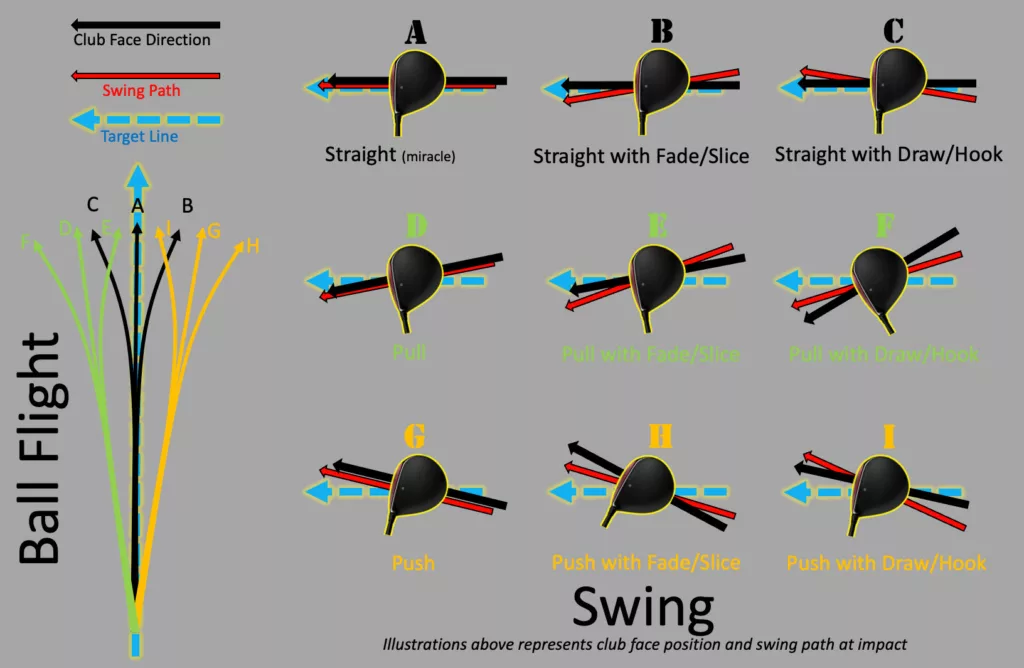
There are 9 ball trajectory patterns to be aware of. Swing path and club face at impact will determine your ball’s trajectory.
This golf ball trajectory chart can help you understand the relationship between the swing and outcomes for each of the 9 patterns.
Lets start with a miracle – a straight shot!
Straight
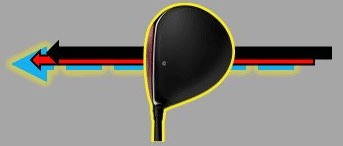
If this is you, let’s talk! I’d like to see if you offer lessons…
Not much to say here, other than explaining the legend. Black line = Club Face angle. Red line equals swing path.
Ball Starts Straight – Finishes with Fade or Slice
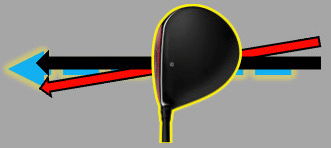
This is your typical out-to-in swing. The severity of the angle is will really determine whether it becomes a giant slice or if it fades off.
The club face is open relative to its path, that is a textbook slice!
Correction is simply to shallow your swing. You may also hear: “get into the slot”, or “drop your elbow first”. I’ve heard a ton of different ways instructors have described it.
Ball Starts Straight – Finishes with a Draw or Hook
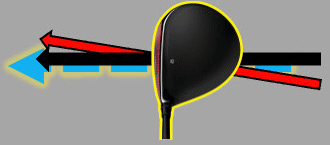
The club face here is closed relative to its swing path.
This is your typical in-to-out swing. Depending on how severe the angle is will really determine whether it becomes a giant hook or if it draws inward.
Pull
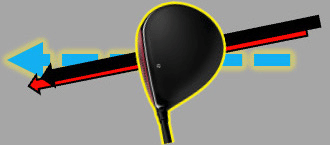
When your club face and swing path are the same, the ball is going to go straight. But in this case, those are both left of the target resulting in a pull.
Pull with Fade/Slice
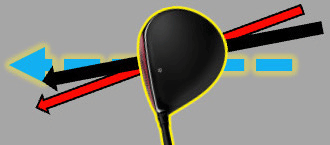
If your club face is left of the target line and the face is open to your swing path, this will result in the ball starting off to the left and finishing with a curve to the right.
Pull with Draw/Hook
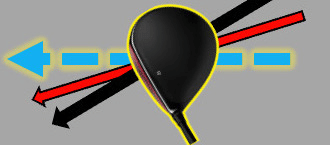
Ahh, this one is my worst enemy! When you swing from over the top, or out-to-in, and you manage to close the club face, your ball is going to start left and then hook. Some people call this a “pull hook”.
Push
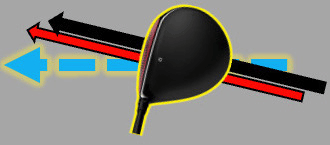
This is your typical push, the ball will travel straight, but it is going to end up to the right of your target line.
Push with Fade/Slice
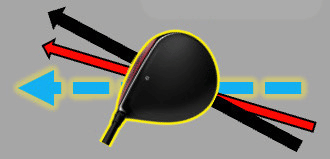
This one is my wife’s worst enemy. Ball starts out to the right and fades off at the end.
Push with Draw/Hook
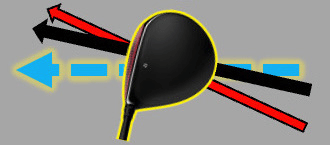
This one is going to result in the ball flight starting out to the right, but moving back toward the target.
New Ball Flight Laws vs. Old Ball Flight Laws
It was previously believed that swing path was the primary factor in how your ball starts out, but we now know it is more heavily influenced by club face.
So what? Well, honestly, it probably doesn’t matter if you know the old ball flight laws and how they have evolved. Pro’s and instructors instinctively knew things were off when someone sliced a ball and they had a really really good idea as to why.
Bottom line – Old ball flight laws say start line is determined by club path. New ball flight laws say start line is determined by club face.
In this article, I break down the differences in a draw vs fade, then provide some resources on how to hit each one!
How to Make Corrections
I am certainly not a swing coach, but I have personally experienced probably every single one of these golf ball flight paths. Simply understanding the mechanics behind them can help you apply that knowledge on the golf course.
I’ve been lucky enough to dial in my driver after a couple of bad holes. Usually I’ll make a mistake, then overcorrect, followed by a decent drive. It takes a couple of holes to figure it out, but I think that’s certainly better than the alternative of simply doing the same bad thing over and over and have no idea why!
Understanding these will help you make those corrections for yourself. From there, you’ll start getting more accuracy and can work on increasing your swing speed!
Correcting a Slice
Personally, I have found Hank Haney’s advice resonates. Hank was one of Tiger Woods coaches and he does a great job of explaining why a golfer will slice and how to easily correct it.
Correcting a Hook
Hooking the ball has been my biggest problem as of late. I’ve found that my grip is too strong, and when I’ve made subtle adjustments, things improve. One of my favorite YouTube golf pros is Rick Shiels, he does a great job of describing how to correct a hook.
Practice Tips
When it’s time for you to follow the advice of these two, I’d highly recommend practicing with an alignment rod. If you don’t have one, you can use a club. Just make sure you are properly aimed at your target.
You can also develop a solid pre-shot routine and learn visualization exercises to improve your game and ability to execute!
Final Thoughts
Start line is determined by clubface at impact. Shot shape is determined by clubface angle relative to swing path. It’s really that simple. Understanding the basics of each of these golf ball flight laws will help you diagnose and correct problems during play.
Good luck on the golf course!
